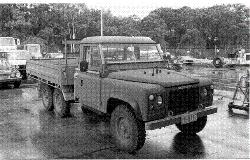110 County 4BD1 LT95's are .998, same as the perentie except for the tapered roller shaft. The gears (45/26 teeth) are identical except for the machining to accept the bearing races.
Are the transfer ratio in the Stage II (110) 4BD1 LT95 the same as the 0.998:1 Perentie 110 or are they the same as the Stage 1 (109) 4BD1?
You won't find me on: faceplant; Scipe; Infragam; LumpedIn; ShapCnat or Twitting. I'm just not that interesting.
110 County 4BD1 LT95's are .998, same as the perentie except for the tapered roller shaft. The gears (45/26 teeth) are identical except for the machining to accept the bearing races.
Cheers......Brian
1985 110 V8 County
1998 110 Perentie GS Cargo 6X6 ARN 202516 (Brutus)
Stage II ???? Never heard that term refering to 110s before
Enlighten me, have I missed something, or is Diana working too hard AGAIN
Danny
You hear people who have been closely involved with Land Rovers for decades like Brian Danielson from Land Vehicle Spares talk about. In the UK they talk anout the SIII V8, yet we call it the Stage 1, Brian talks about the early 110 and 120 (the type that still have the same doors etc as the SIII) as Stage II although it may only include the coil sprung vehicles which had the SIII body including the split windscreen.

Although both pics are of 6X6, note the wheel arch extensions and the split screen. In the V8 one jumping you can see daylight through the front LHS wheelarch where you would normally expect to see part of the leaf spring pack.
You won't find me on: faceplant; Scipe; Infragam; LumpedIn; ShapCnat or Twitting. I'm just not that interesting.
Ive never heard of them called a stage II they were known as 110 comercial tray backs first one i saw was at rumbels in 85 when the oldman brought the stage I county wagon they had a brand new coil cab 120 with series doors and windscrean.
As for transfer ratios all LT95's fitted to isuzu's got .996:1 high range which is the same box used in the last of the 4 speed rangie's 83/84 mod or phase 1 as they are known as.
The 6x6 Perentie taper roller fitted LT95's seem to have gotten a 1.113:1 high range, at least mine did. Now has a .996 as it isn't in a 6x6..
JC
While the Series III V8 & introduction of the One Ten/Ninety may be the obvious end result of Stage One & Stage Two of the re-investment plan into LR respectively, there were other benefits as well.
During the 1970s as all the profits generated by Range Rover & Series III were pumped back into the other loss making divisions of British Leyland, the cash cows were left to stagnate. Think what actually changed with the Series III from it's introduction in 1971 up to the introduction of the V8 in 1979? The Ryder Report of 1975 suggested 400 million pounds should be invested by the British government (owners of BL by this stage) into doubling LR/RR production with LR to be run autonomously. In 1978 newly appointed Land-Rover Ltd (a division of Jaguar-Rover-Triumph Ltd) MD Mike Hodgkinson saw the error of doubling production without investing in development. A revised five year/280 million pound plan was approved, with an initial 30m already starting when publicly announced in August of 1978. This Stage One of investment included a V8 LR, a facelift for RR & an increase in production capacity of 8.5% for LR & 50% for RR. This was finished by November 1979.
Stage Two of the plan resulted in, amongst other things, a four-door body in 1981 for RR, re-engineered 2.25 L engines with five main bearings, new variants of existing models (County & HCPU in April 1982), a new engine assembly plant, and ultimately the One Ten (1983) & Ninety (1984). The excellent result of the original plan, finished in June 1984, allowed for further investment & continued success.
Rob W
| Search AULRO.com ONLY! |
Search All the Web! |
|---|
|
|
|
Bookmarks